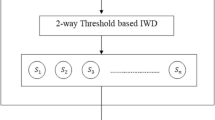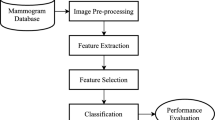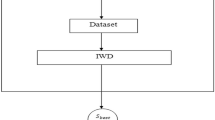Abstract
Breast cancer is one of the significant tumor death in women. Computer-aided diagnosis (CAD) supports the radiologists in recognizing the irregularities in an efficient manner. In this work, a novel CAD system proposed for mammogram image analysis based on grey wolf optimizer (GWO) with rough set theory. Texture, intensity, and shape-based features are extracted from mass segmented mammogram images. To derive the appropriate features from the extracted feature set, a novel dimensionality reduction algorithm is proposed based on GWO with rough set theory. GWO is a novel bio-inspired optimization algorithm, stimulated based on hunting activities and social hierarchy of the grey wolves. In this paper, a hybridization of GWO and Rough Set (GWORS) methods are used to find the significant features from the extracted mammogram images. To evaluate the effectiveness of the proposed GWORS, we compare it with other well-known rough set and bio-inspired feature selection algorithms including particle swarm optimize, genetic algorithm, Quick Reduct and Relative Reduct. From empirical results, it is observed that the proposed GWORS outperforms the other techniques in terms of accuracy, F-Measures and receiver operating characteristic curve.














Similar content being viewed by others
References
American Cancer Society (2021) How Common Is Breast Cancer? https://www.cancer.org/cancer/breast-cancer/about/how-common-is-breast-cancer.html
The National Cancer Registry Programme (2020). https://www.ncdirindia.org/All_Reports/Report_2020/default.aspx
Guo YN, Dong M, Yang Z, Gao X, Wang K, Luo C, Zhang J (2016) A new method of detecting micro-calcification clusters in mammograms using contourlet transform and non-linking simplified PCNN. Comput Methods Prog Biomed 130:31–45
Dong M, Lu X, Ma Y, Guo Y, Ma Y, Wang K (2015) An efficient approach for automated mass segmentation and classification in mammograms. J Digit Imaging 28(5): 613–625
Cheng HD, Cai X, Chen X, Hu L, Lou X (2003) Computer-aided detection and classification of microcalcifications in mammograms: a survey. Pattern Recogn 36:2967–2991
Pacheco F, Cerrada M, Sánchez RV, Cabrera D, Li C, de Oliveira JV (2017) Attribute clustering using rough set theory for feature selection in fault severity classification of rotating machinery. Expert Syst Appl 71:69–86
Dash M, Liu H (1997) Feature selection for classification. Intell Data Anal 1(3):131–156
Kumar SU, Inbarani HH (2016) PSO-based feature selection and neighborhood rough set-based classification for BCI multiclass motor imagery task. Neural Comput Appl 28:1–20
Jothi G, Inbarani HH (2016) Hybrid Tolerance Rough Set-Firefly based supervised feature selection for MRI brain tumor image classification. Appl Soft Comput 46:639–651
Bazan JG, Peters JF, Skowron A (2005) Behavioral pattern identification through rough set modelling. In: Ślęzak D., Yao J., Peters J.F., Ziarko W., Hu X. (eds) Rough sets, fuzzy sets, data mining, and granular computing (RSFDGrC), Lecture Notes in Computer Science, vol 3642. Springer, Berlin, Heidelberg, pp 688–697. https://doi.org/10.1007/11548706_73
Kumar SU, Inbarani HH (2015) A novel neighborhood rough set based classification approach for medical diagnosis. Procedia Comput Sci 47:351–359
Guyon A (2003) Elisseeff, an introduction to variable and feature selection. J Mach Learn Res 3:1157–1182
Inbarani HH, Azar AT, Jothi G (2014) Supervised hybrid feature selection based on PSO and rough sets for medical diagnosis. Comput Methods Prog Biomed 113:175–185
Si-Yuan J (2014) A hybrid genetic algorithm for feature subset selection in rough set theory. Soft Comput 18:1373–1382
El Aziz MA, Hassanien AE (2016) Modified cuckoo search algorithm with rough sets for feature selection. Neural Comput Appl 4:1–10
Chen Y, Zeng Z, Lu J (2016) Neighborhood rough set reduction with fish swarm algorithm. Soft Comput 21:1–12
Hassanien AE, Gaber T, Mokhtar U, Hefny H (2017) An improved moth flame optimization algorithm based on rough sets for tomato diseases detection. Comput Electron Agric 136:86–96
Abubacker NF, Azman A, Doraisamy S, Murad MAA (2016) An integrated method of associative classification and neuro-fuzzy approach for effective mammographic classification. Neural Comput Appl 28:1–14
Martins L, Junior GB, Silva AC, de Paiva AC, Gattass M (2009) Detection of masses in digital mammograms using K-means and support vector machine. ELCVIA Electron Lett Comput Vis Image Anal 8(2):39–50
Jaleel JA, Salim S, Archana S (2014) Textural features based computer aided diagnostic system for mammogram mass classification. In: IEEE 2014 international conference on control, instrumentation, communication and computational technologies (ICCICCT). pp 806–811. https://doi.org/10.1109/ICCICCT.2014.6993069
Jona J, Nagaveni N (2012) A hybrid swarm optimization approach for feature set reduction in digital mammograms. WSEAS Trans Inf Sci Appl 9:340–349
Gorgel P, Sertbaş A, Kilic N, Osman O et al (2012) Mammographic mass classification using wavelet based support vector machine. IU-J Electr Electron Eng 9(1):867–875
Dheeba J, Albert Singh N, Tamil Selvi S (2014) Computer-aided detection of breast cancer on mammograms: a swarm intelligence optimized wavelet neural network approach. J Biomed Inform 49:45–52
Pereira DC, Ramos RP, DoNascimento MZ (2014) Segmentation and detection of breast cancer in mammograms combining wavelet analysis and genetic algorithm. Comput Methods Prog Biomed 114(1):88–101
Agrawal P, Vatsa M, Singh R (2014) Saliency based mass detection from screening mammograms. Signal Process 99:29–47
Muramatsu C, Hara T, Endo T, Fujita H (2016) Breast mass classification on mammograms using radial local ternary patterns. Comput Methods Prog Biomed 72:43–53
Jiao Z, Gao X, Wang Y, Li J (2016) A deep feature based framework for breast masses classification. Neurocomputing 197:221–231
Gedik N, Atasoy A, Sevim Y (2016) Investigation of wave atom transform by using the classification of mammograms. Appl Soft Comp 43:546–552
Varela C, Tahoces PG, Méndez AJ, Souto M, Vidal JJ (2007) Computerized detection of breast masses in digitized mammograms. Comput Biol Med 37(2):214–226
El-Baz E (2015) Hybrid intelligent system-based rough set and ensemble classifier for breast cancer diagnosis. Neural Comput Appl 26(2):437–446
Azar AT, El-Said SA (2014) Performance analysis of support vector machines classifiers in breast cancer mammography recognition. Neural Comput Appl 24(5):1163–1177
Pawlak Z (1982) Rough sets. Int J Comput Inf Sci 11(5):341–356
Pawlak Z, Skowron A (2007) Rough sets: some extensions. Inform Sci 77:28–40
Pawlak Z (1991) Rough sets: theoretical aspects of reasoning about data. Kluwer Academic Publishing, Dordrecht
Swiniarski RW, Kowron A (2003) Rough set methods in feature selection and recognition. Pattern Recogn Lett 24:833–849
Mirjalili S, Mirjalili SM, Lewis A (2014) Grey wolf optimizer. Adv Eng Softw 69:46–61
Mirjalili S, Saremi S, Mirjalili SM, Coelho LDS (2016) Multi-objective grey wolf optimizer: a novel algorithm for multi-criterion optimization. Expert Syst Appl 47:106–119
Daniel E, Anitha J, Kamaleshwaran KK, Rani I (2017) Optimum spectrum mask based medical image fusion using gray wolf optimization. Biomed Signal Proces 34:36–43
Suckling J, Parker J, Dance D, Astley S, Hutt I, Boggis C, Ricketts I, Stamatakis E, Cerneaz N, Kok S, Taylor P (2015) Mammographic image analysis society (MIAS) database v1.
Thangavel K, Roselin R (2012) Fuzzy-rough feature selection with π-membership function for mammogram classification. Int J Comput Sci Issues 9:361–371
Otsu N (1979) A threshold selection method from grey level histogram. IEEE Trans Syst Man Cybern 9(1):62–66
Sreedevi S, Sherly E (2015) A novel approach for removal of pectoral muscles in digital mammogram. Procedia Comput Sci 46:1724–1731
Haralick RM, Shanmugam K (1973) Dinstein, textural features for image classification. IEEE Trans Syst Man Cybern 3(6):610–621
Velayutham C, Thangavel K (2011) Unsupervised quick reduct algorithm using rough set theory. J Electron Sci Technol 9(3):193–201
Kumar SU, Inbarani HH (2016) Neighborhood rough set based ECG signal classification for diagnosis of cardiac diseases. Soft Comput 21:1–13
Vibha L, Harshavardhan GM, Pranaw K, Deepa Shenoy P, Venugopal KR, Patnaik LM (2006) Classification of mammograms using decision trees. In: Proceedings of the 10th IEEE international database engineering and applications symposium (IDEAS’06). pp 263–266
Krishnaveni S, Bhanumathi R, Pugazharasan T (2014) Study of mammogram microcalcification to aid tumour detection using Naive Bayes classifier. Int J Adv Res Electr Electron Instrum Eng 3:8274–8282
Yamany W, Emary E, Hassanien AE (2015) New rough set attribute reduction algorithm based on grey wolf optimization. In: The 1st international conference on advanced intelligent system and informatics (AISI2015), November 28–30, Beni Suef, Egypt. Springer, pp 241–251
Nagarajan V, Britto EC, Veeraputhiran SM (2019) Feature extraction based on empirical mode decomposition for automatic mass classification of mammogram images. Med Novel Technol Devices 1:100004
Krizhevsky A, Sutskever I, Hinton GE (2012) ImageNet classification with deep convolutional neural networks. In: Proceedings of the 25th International Conference on Neural Information Processing Systems, vol 1 (NIPS'12). Curran Associates Inc., Red Hook, NY, USA, pp 1097–1105.
Zeiler MD, Fergus R (2014) Visualizing and understanding convolutional networks. In: Fleet D, Pajdla T, Schiele B, Tuytelaars T (eds) Computer Vision – ECCV 2014. ECCV 2014. Lecture Notes in Computer Science, vol 8689. Springer, Cham. https://doi.org/10.1007/978-3-319-10590-1_53
Szegedy C, Liu W, Jia Y, Sermanet P, Reed S, Anguelov D et al (2015) Going deeper with convolutions. In: Proceedings of the IEEE conference on computer vision and pattern recognition. pp 1–9
Acknowledgements
The authors would like to thank the Department of Science and Technology (DST), India for their financial assistance through the improvement of Science for Equity Empowerment and Development (SEED) programme (Grant No: SEED/WS/018/2015). The experimental analysis performed in Data Analytics and Solutions Lab (Catalyzed & Supported by SEED Division, DST, New Delhi), Sona College of Technology, Salem, Tamilnadu, India.
Author information
Authors and Affiliations
Corresponding author
Ethics declarations
Conflict of interest
The authors declared that they have no conflicts of interest to this work.
Additional information
Publisher's Note
Springer Nature remains neutral with regard to jurisdictional claims in published maps and institutional affiliations.
Rights and permissions
About this article
Cite this article
Sathiyabhama, B., Kumar, S.U., Jayanthi, J. et al. A novel feature selection framework based on grey wolf optimizer for mammogram image analysis. Neural Comput & Applic 33, 14583–14602 (2021). https://doi.org/10.1007/s00521-021-06099-z
Received:
Accepted:
Published:
Issue Date:
DOI: https://doi.org/10.1007/s00521-021-06099-z




